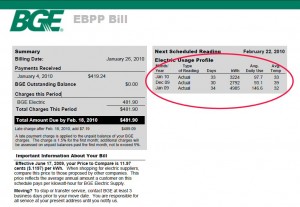
We just received our energy bill for December and January; this is the first bill that shows the full effect of installing spray foam insulation in our basement.
Recall that last year our basement was entirely uninsulated. The only thing between us and the elements were cinder blocks with basement waterproof sealer applied to them.
Our first floor flooring was freezing, and the entire house was drafty. Ultimately, we selected closed cell spray foam from a variety of basement wall insulation options.
We had a local spray foam contractor install the insulation and our subjective experience since then has been great. (In fact, the basement is now the warmest room in our house). Until now, we didn’t have any objective proof that the investment was worth it.
Now we do.
This energy bill confirms our subjective experience with facts. Take a look (click the picture to enlarge and make the numbers legible)…
Energy Savings Analysis
Last January (2009), you can see that our average energy use for the house was a whopping 146.6 KWh / day! This January (2010), our energy use drops to an average of 97.7 KWh / day. This represents about a 33% energy savings, despite the fact that this year’s daily temperature average was 1 degree colder.
Our house is in approximately the same shape as last year, with the same number of people living in it. There are a few differences in the house:
- Last year, we had a large aquarium that we also heated throughout the Winter. While the heat from that aquarium ultimately leaked back into the room, there would still be some increased cost. Our estimate is that the aquarium used approximately $25 / month in energy.
- This year, we’ve been using the fireplace almost every night. Fireplaces are notoriously energy inefficient. They steal heat from a house at a rate much higher than they add back with radiant heat. We still like to look at the fire, though, and we’re willing to pay for for the privilege. I estimate we’ve been losing about $10-$20 / month in energy to the fireplace.
Other than these two differences, the house is in approximately the same shape as last year, with the same number of inhabitants. In other words, we think the bulk of the 33% savings is directly attributable to the spray foam insulation.
Tax Savings for Spray Foam Insulation
The best part: 30% of the cost of the insulation material will be refunded to us this year through the U.S. Government’s tax credits for energy program.
This makes our payback period for the insulation less than 3 years, and potentially even less than 24 months, depending on how the foam performs in the Winter.







